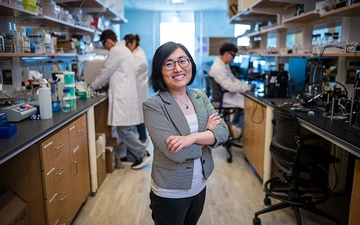U of A scientists recognized with prestigious NIH 'New Innovator' awards

From pioneering spinal cord bioimplants to uncovering surprising links between the gut and the brain, University of Arizona researchers are redefining what's possible in human health. The National Institutes of Health, the nation's leading medical research agency, recognized that groundbreaking innovation with two major grants.
Shang Song, the Frank L. and Daphna Lederman Professor and assistant professor of biomedical engineering in the College of Engineering, and M. Maya Kaelberer, an assistant professor of physiology in the College of Medicine – Tucson, each received the institute's prestigious New Innovator Award, which supports "bold and highly innovative research projects" with the potential to make broad and lasting impacts on human health.
The award is part of the organization's "High-Risk, High-Reward Research" program, which funds unconventional approaches to major challenges in biomedical and behavioral research.
Building better backs

Shang Song, the Frank L. and Daphna Lederman Professor and assistant professor of biomedical engineering, supervises students in The Song Lab investigating health care devices that speed injury recovery.
College of Engineering
According to the American Association of Neurological Surgeons, more than 17,000 Americans annually suffer spinal cord injuries, which can lead to acute chronic pain and loss of motor function. In an effort to aid those struggling after injuring, Song is developing a bioimplant that treats spinal cord injuries and their associated complications.
The device leverages neuroplasticity, the ability of nerve cells to reconnect and form pathways to perform body functions, to treat spinal column damage.
"Other neurological functions of the body, like heartbeat, breathing and bowel function, can also be affected," Song said. "Even in less severe cases, quality of life can be drastically lowered."
Song was awarded $2.32 million to develop her implant, which uses electrical stimulation to promote neural learning and plasticity, forge neural connections and retrain the nervous system.
The device encourages the spinal cord to find neural pathways that reduce pain while promoting motor recovery. With repeated stimulation, the spinal cord learns which signals improve movement and decrease discomfort. It also incorporates biodegradable, FDA-approved materials that break down in the body naturally, with material components adjusted depending on the required treatment period. This design eliminates the need for removal surgery and reduces the risk of long-term complications.
"Traditionally, the spinal cord has been viewed as a hard-wired and passive conduit, merely relaying signals," Song said. "However, this view is incomplete. The spinal cord has a remarkable ability to adapt and that gives us the key to restoring its function."
Read more about Song's research on the College of Engineering's website.
The mysteries of 'nutritional memory'

M. Maya Kaelberer is an assistant professor of physiology at the College of Medicine – Tucson.
Noelle Haro-Gomez, U of A Health Sciences Office of Communications
Kaelberer's award includes a $1.5 million grant to support her investigations into cells called neuropods, which send signals from the intestine to the reward center of the brain through the vagus nerve. Kaelberer will explore how maternal diet influences offspring food choices later in life. Her previous work showed that when mice ate high-fat and high-sugar diets during pregnancy, their offspring were more likely to gain weight – even when eating the same diet as other mice.
Kaelberer will investigate the extent of this maternal connection by making sweetened condensed milk freely available to the mom, then testing the gut sugar sensitivity of the offspring. Her hypothesis is that mice exposed to a high-fat, high-sugar diet in the womb will have guts that are wired to require denser calorie sources to feel satisfied.
"I'm trying to create as natural a situation as possible, similar to how we eat," she said. "We have our fresh vegetables, but someone brings in cookies, and we have five of them. We're really good at supplementing our diet with stuff that is not very good for us. Likewise, mice will drink a ton of sweetened condensed milk, but they'll have their normal chow as well."
Kaelberer's previous studies found a particularly long-lived type of neuropod that could be the key to storing nutritional memory and play a significant role in the stability of food preferences. She will remove the long-lived neuropods that are sensitized toward certain types of nutrients like fat and sugar to see if the mice begin making different decisions.
Kaelberer believes a better understanding of the gut-brain connection could provide a peek into people's differing food choices, discoveries that could enable dietitians to design diets that are easier to follow.
Read more about Kaelberer's research on the Office of Research and Partnerships website.





